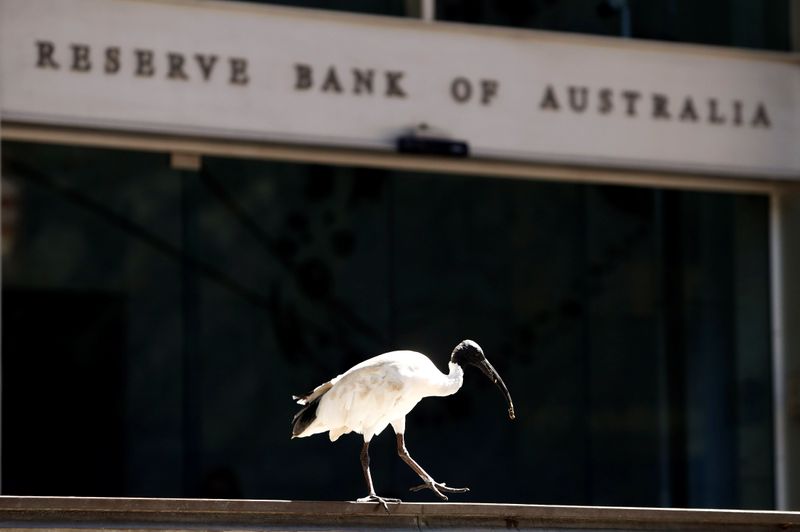
FILE PHOTO: An ibis bird perches next to the Reserve Bank of Australia headquarters in central Sydney, Australia February 6, 2018. REUTERS/Daniel Munoz/File Photo
April 7, 2020
By Swati Pandey and Wayne Cole
SYDNEY (Reuters) – Australia’s central bank kept rates at record lows on Tuesday and said it would do “what is necessary” to achieve its target of 0.25% for three-year government bond yields as it predicted a “very large” economic contraction next quarter.
The Reserve Bank of Australia (RBA) on March 19 announced an out-of-cycle rate cut to 0.25% together with an unprecedented stimulus package, which included an unlimited bond buying programme.
On Tuesday, the board affirmed all the elements of that package and said it would not raise interest rates until it makes progress in achieving its employment and inflation goals.
“There is considerable uncertainty about the near-term outlook for the Australian economy,” Governor Philip Lowe said in a short post-meeting statement.
“Much will depend on the success of the efforts to contain the virus and how long the social distancing measures need to remain in place,” Lowe added.
“A very large economic contraction is, however, expected to be recorded in the June quarter and the unemployment rate is expected to increase to its highest level for many years.”
There is already growing evidence of a marked slowdown in activity as the total number of confirmed COVID-19 cases in Australia creeps towards 6,000 with 46 deaths.
Restrictions on human movement and gatherings have forced many businesses in hospitality, retail, transport, education and even community services to shut down. Businesses that remain open face falling sales and increasing operational restrictions.
Indeed figures out earlier in the day were ominous.
The Australian Industry Group Australian Performance of Services Index plunged to 38.7 points in March, the lowest since March 2009 and the fourth month of contraction.
Separate figures from Australia and New Zealand Banking Group <ANZ.AX> showed Australian job advertisements suffered their largest drop in more than a decade in March.
Another survey from ANZ and Roy Morgan also out on Tuesday showed consumer sentiment bounced last week after two months of drastic falls, as a government “JobKeeper” plan to subsidise some workers lightened the mood just a little.
The survey’s main index rose 10.1% from the previous week, yet was still close to the lows seen in the recession of the early 1990s.
Economists fear unemployment could spike toward 10% in coming months as large chunks of the economy all but close to fight the virus. The jobless rate stood at 5.1% in February before rolling shutdowns threw many out of work.
“Prior to the JobKeeper payment announcement, we forecast that more than 1.1 million workers could lose their jobs and the unemployment rate could rise to a peak of 13%,” said ANZ senior economist, Catherine Birch.
“However, we think the JobKeeper payment will keep more workers employed and reduce the peak in unemployment – the economic version of ‘flattening the curve’.”
Australia’s trade balance also narrowed a touch to A$4.36 billion ($2.67 billion) with earnings from tourism sliding 15% in February to be down A$1 billion in just two months, data from the Australian Bureau of Statistics (ABS) showed on Tuesday.
(This story corrects central bank phrasing in paragraph 1)
(Editing by Sam Holmes)

